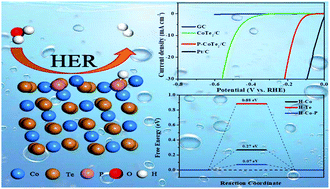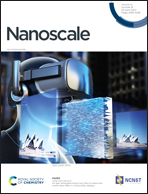Phosphorus-doped CoTe2/C nanoparticles create new Co–P active sites to promote the hydrogen evolution reaction†
Abstract
Doping has been widely recognized as an effective method for adjusting the performance of electrocatalysts. It can cause changes in the electronic structure of substances. Thereby, it can affect the intrinsic catalytic performance. Herein, we report a facile doping method in which phosphorus can be simultaneously doped into both CoTe2 and C. In the acidic solution, the hydrogen evolution reaction (HER) performance of the obtained P-CoTe2/C nanoparticles was significantly improved compared with that of undoped nanoparticles. At a current density of 10 mA cm−2, the overpotential decreased from 430 mV to 159 mV. Density functional theory (DFT) calculations show that phosphorus doping can produce new high activity Co–P catalytic sites. In addition, phosphorus can be doped into the carbon in the composite at the same time, which enhances the electrical conductivity of the composite. Moreover, in the process of calcination and doping, the electric double layer capacitance (Cdl) of the composite is significantly increased, which helps in exposing more active sites. This work has developed a multi-effect doping method that simultaneously increases the intrinsic activity, conductivity and active sites of the material. This method provides a new strategy for the performance regulation of other electrocatalysts.



 Please wait while we load your content...
Please wait while we load your content...